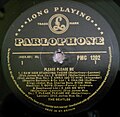Parlophone
| Parlophone Records | |
|---|---|
| File:Parlophone.jpg.gif | |
| Parent company | EMI |
| Founded | 1896 |
| Founder | Carl Lindstrom |
| Distributor(s) | Parlophone Records (In the UK) |
| Genre | Various |
| Country of origin | UK |
| Official website | http://www.emimusic.co.uk/04/parlophone.htm |
Parlophone is a record label, founded in Germany in 1896 by the Carl Lindstrom Company. The ₤ trademark may resemble the British pound sign (£), but it is actually a German L, for Lindstrom. During the First World War, the Transoceanic Trading Company was set up in the Netherlands to look after its overseas assets. In 1923, the British branch of Parlophone was established, led by Oscar Preuss as its A&R manager. Parlophone established a master leasing arrangement with co-owned United States based Okeh Records, making Parlophone a leading jazz label in the UK. In 1927, Columbia Graphophone Company of the United Kingdom acquired a controlling interest in the Carl Lindstrom Company and thereby in Parlophone. In 1931, Columbia merged with the Gramophone Company to form Electric & Musical Industries Ltd (EMI).
Under EMI, Parlophone initially maintained its status as a jazz label. As time went on, the label also released speciality music, spoken-word and novelty/comedy material, such as the comedy recordings of The Goons. In 1950, Preuss hired 24-year-old George Martin as his assistant. In 1955, Preuss retired and Martin succeeded him. Leading Parlophone artistes at the time included Germany's Obernkirchen Children's Choir, Scottish musician Jimmy Shand and the pianist Mrs Mills.
Under the original agreement between Parlophone and US OKeh, worldwide rights to pre-1935 US OKeh product was and continues to be handled by Parlophone, now EMI. This arrangement continues despite US OKeh's ownership changes (Columbia, ARC, CBS, Sony, Sony/BMG).
At the dawn of the rock era, Parlophone artists such as Humphrey Lyttelton, The Vipers, Jim Dale, Keith Kelly, the Temperance Seven and Shane Fenton would sporadically reach the British Top 20 chart. However, their only consistent chart action until the "Beat Boom" would be that of teen idol Adam Faith, who was not a Martin discovery: Faith was assigned to the label via EMI's A&R man-without-portfolio, Norman Newell. Treading a path similar to other British labels of the era, Parlophone released all manner of domestic and foreign licensed product (including James Brown), but had little success in comparison to EMI siblings HMV and Columbia.
The label's fortunes began to rise in 1962, when Martin signed a rising new Liverpool pop band, The Beatles. Along with Brian Epstein-managed stablemates Cilla Black, Billy J. Kramer and the Fourmost, they soon turned Parlophone into one of the world's most famous and prestigious record labels.
After Martin decided to become an independent producer in 1965, the Parlophone Company was absorbed into EMI's Gramophone Company unit with the label intact.
Thanks to the Beatles' recordings, Parlophone claimed the best selling UK single "She Loves You" (until 1977), and the best selling UK album "Sgt. Pepper's Lonely Hearts Club Band".
The label also placed a tally of seven singles at number 1 during 1964, when it also claimed top spot in the album charts for 40 of the 52 weeks.
Parlophone is still a leading EMI label, while of its contemporary labels HMV became solely a classical music label and Columbia was replaced by the EMI label.
Notable acts
Since The Beatles, many other pop/rock artists have signed to the label, including:
- The Hollies
- Silent Running
- Simon Dupree and the Big Sound
- Queen
- The Easybeats
- Paul McCartney
- Duran Duran
- The Church
Recently the label's line-up has included acts such as:
- Athlete
- Supergrass
- Radiohead
- Babyshambles
- Coldplay
- Beverley Knight
- Jamelia
- Kylie Minogue
- Pet Shop Boys
- Blur
- All Saints
- Gorillaz
- The Divine Comedy
- Lily Allen
- Siobhan Donaghy
- Interpol
-
"Parlophon" ad from 1927, Berlin
-
Parlophone trademark during The Beatles era
Parlophone record labels
-
Early Parlophone record label
-
Please Please Me by The Beatles (side 1) - 1963. Parlophone gold and black label
-
With the Beatles (side 1) - Parlophone yellow and black label
The labels shown here include those used for 78s and LPs. The label design for 7" singles had the same standard template as several other EMI labels, with the large "45" insignia to the right. In recent years, design uniformity has relaxed from release to release.




